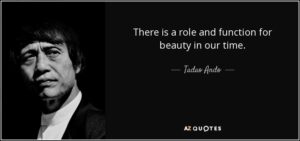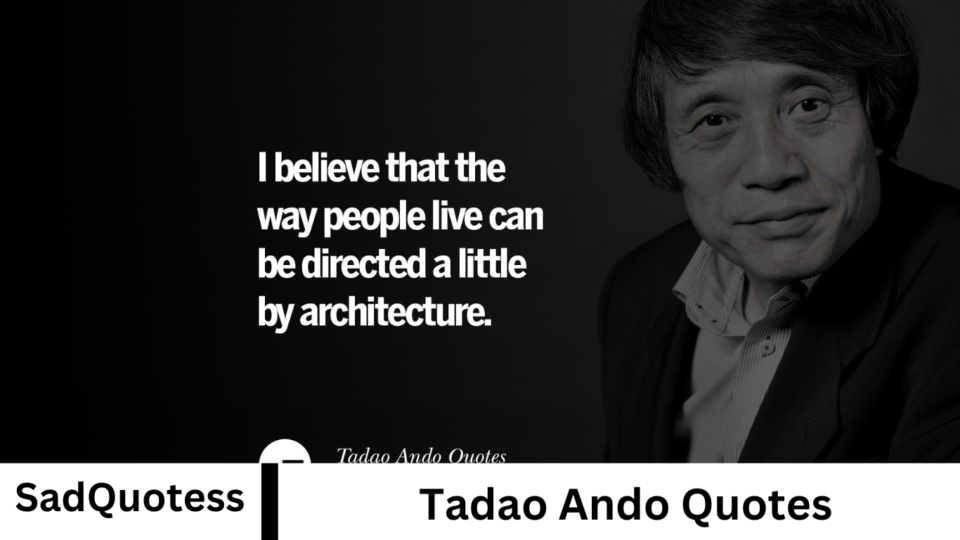Famous Japanese architect Tadao Ando is known for his minimalist designs, creative use of concrete, and substantial connection between space and nature. Born in 1941, Ando is a self-taught architect whose work embodies simplicity, light, and tranquility. He often draws inspiration from traditional Japanese aesthetics. His designs, like the Row House in Sumiyoshi and the Church of the Light, emphasize the interaction of light, shadow, and geometry to create serene and contemplative spaces.

The quotes from Ando show that he views architecture as an emotional and spiritual experience rather than just a structure that works. He frequently discusses the value of personal experience in shaping space, the harmony between architecture and nature, and the power of simplicity. His words continue to inspire architects, designers, and creatives worldwide.
Early Life and Birth
Tadao Ando was born on September 13, 1941, in Osaka, Japan. Raised in a working-class neighborhood, Ando had a modest upbringing, which was far removed from the world of architecture he would later come to dominate. His father was absent for most of his early life, and his mother, a strong influence on him, worked tirelessly to support the family. Ando’s early experiences shaped his resilient character and a deep desire for self-improvement.
As a young man, Ando initially pursued boxing before discovering his passion for architecture. Largely self-taught, he did not attend formal architecture school, instead gaining knowledge through books and hands-on experience. His decision to become an architect was influenced by his travels and time spent in Europe, where he visited iconic architectural sites, particularly the works of Le Corbusier. This exposure to modernist architecture laid the foundation for Ando’s future design philosophy.
Career and Success
Tadao Ando’s career in architecture began in the 1960s when he founded his practice, Tadao Ando Architect & Associates, in Osaka. His approach to architecture is characterized by minimalism, a profound respect for nature, and an innovative use of concrete, light, and space. Ando’s philosophy emphasizes simplicity and harmony between the built environment and the natural world. He is mainly known for blending traditional Japanese design elements with modernist architecture, creating serene, contemplative spaces.

One of Ando’s defining characteristics as an architect is his mastery of concrete. He is known for using exposed, smooth concrete walls as a central design element in many of his buildings. Ando has been praised for his ability to shape light and shadow in ways that evoke emotional responses from visitors, creating spaces that feel both modern and timeless.
Some of his most iconic works include the Church of the Light (1989) in Osaka, the Water Temple (1991) in Hyogo, and the Naoshima Contemporary Art Museum (1992). These projects exemplify Ando’s minimalist approach and his focus on creating spiritual and experiential spaces. His work often emphasizes open spaces and the interplay of light and shadow, as seen in the Church of the Light, where the cross-shaped window casts a profound light that becomes a spiritual focal point.
Death and Legacy
While Tadao Ando is still alive, his work continues to leave an indelible mark on the field of architecture. His influence is not only seen in his completed buildings but also in his approach to the relationship between nature and architecture and his innovative use of materials. His designs have inspired architects worldwide, and his philosophical approach to architecture continues to be studied and admired.
Ando’s legacy is also felt in his teaching. He has taught at prestigious universities such as the University of California, Los Angeles (UCLA), and the University of Tokyo. Through his lectures, Ando has inspired the next generation of architects, sharing his design principles and his vision of creating architecture that fosters a deep emotional connection between the space and its inhabitants.
His projects are not just architectural feats; they also serve as places for contemplation and reflection, making his work profoundly spiritual. Ando’s philosophy of architecture is about creating spaces that encourage a dialogue between the building, the surrounding environment, and the people who interact with it.
Habits and Personal Life
Tadao Ando is known for his simplicity and discipline, both in his personal life and in his work. Despite his fame, Ando lives a relatively private and modest life. His studio in Osaka reflects his minimalist approach to both design and living. Ando is known to work long hours, with a strong commitment to the creative process and meticulous attention to detail. He has said that his design philosophy often comes from a sense of personal introspection and a deep desire to create spaces that are both functional and poetic.

He also strongly believes that architecture should serve people and the environment. Ando has often spoken about the role of an architect as a caretaker of space, and his habit of carefully considering the context of each project is reflected in his designs. For example, many of his projects are deeply rooted in the natural landscape, with a conscious effort to blend the building into the surrounding environment.
Relationships and Influence
Tadao Ando’s relationships in the architectural world are wide-ranging, and fellow architects, designers, and scholars highly respect him. His work is often associated with the broader context of modernist architecture, but Ando has crafted a distinct style that is uniquely his own. While he draws on the influence of architects like Le Corbusier, Ando has also managed to infuse his cultural heritage into his work, blending the traditional Japanese reverence for nature with the modernist movement’s emphasis on functional design.
Throughout his career, Ando has collaborated with various artists and designers, notably in his work with the Benesse Art Site on Naoshima Island, Japan. The partnership with the Benesse Corporation and artists like James Turrell and Yayoi Kusama resulted in some of the most iconic contemporary art museums, combining art and architecture in ways that push the boundaries of both fields.
Ando’s work has also been widely influential on a global scale. He is considered a significant figure in the international architectural community, with his designs influencing contemporary architecture not just in Japan but also in Europe and the United States. His ability to bridge the gap between traditional Japanese culture and modern architectural innovation has earned him widespread acclaim and respect.
Favorite Things and Interests
While much of Tadao Ando’s life is dedicated to his work, his interests extend beyond architecture. Ando has mentioned his deep connection to nature and the outdoors as a key influence on his design process. He enjoys spending time in natural settings, where he can observe and reflect on how light, space and materials interact in the natural world. This passion for nature is evident in his architecture, where the interplay of natural elements is central to many of his designs.

In addition, Ando has a deep appreciation for art, particularly contemporary art, and this is reflected in his collaborations with artists and his design of museum spaces. His projects often serve as a canvas for both architecture and art, as seen in the Benesse Art Site and the Naoshima Contemporary Art Museum. Through these projects, Ando has blended art and architecture to create immersive environments that encourage visitors to experience both simultaneously.
Frequently Asked Questions
Who is Tadao Ando?
Tadao Ando is a Japanese architect known for his minimalist concrete structures that blend simplicity with nature. Born in 1941 in Osaka, he is a self-taught architect who has become one of the most influential figures in contemporary architecture. His designs emphasize light, shadow, and spatial harmony.
What is Tadao Ando famous for?
Ando is famous for his innovative use of raw concrete, geometric precision, and seamless integration of natural elements into his designs. Some of his most renowned works include The Church of the Light, Row House in Sumiyoshi, and Naoshima Art Museum.
What is unique about Tadao Ando’s architecture?
His architecture is characterized by clean lines, exposed concrete, and a deep connection with nature. He often incorporates natural light, wind, and water into his designs, creating spaces that evoke tranquility and reflection.
How did Tadao Ando become an architect?
Ando did not follow a traditional academic path in architecture. Instead, he taught himself by studying books, traveling, and learning from architectural landmarks around the world. His unique, self-driven approach has shaped his distinctive style.
What awards has Tadao Ando won?
He has received numerous prestigious awards, including the Pritzker Architecture Prize (1995), the AIA Gold Medal (2002), and the Order of Culture in Japan (2010).
What is his philosophy on architecture?
Ando believes architecture should engage with nature and create an emotional experience. He emphasizes simplicity, space, and the interplay between light and shadow rather than ornamentation.
How does Ando use concrete in his designs?
He is known for his precise and smooth concrete surfaces, which create a sense of purity and strength. Unlike traditional brutalist architects, Ando softens concrete with natural elements, such as water, trees, and light.
What is Ando’s impact on modern architecture?
His work has influenced architects worldwide. It demonstrates how modernism can coexist with natural elements. His designs have redefined minimalist architecture and inspired new approaches to spatial design.
Conclusion
Tadao Ando is a visionary architect whose minimalist and spiritual approach to design has profoundly influenced the field of architecture. His commitment to creating spaces that foster a deep connection between people, nature, and the built environment has earned him global recognition and admiration. With his innovative use of concrete, his integration of natural elements, and his emphasis on simplicity, Ando has redefined modern architecture. His legacy continues to inspire and shape the future of architectural design, making him one of the most respected figures in contemporary architecture.
